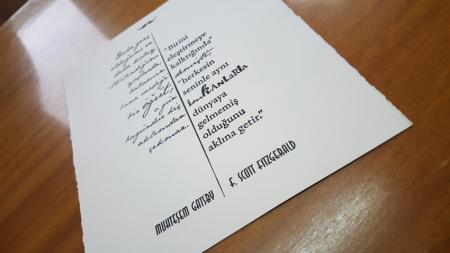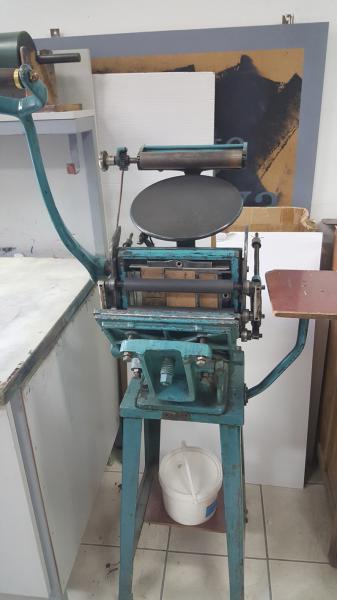impression problem
Hi there. As you’ll understand from my question I’m a newbie. I am trying to use photopolymer plates for letterpress. my plates are DuPont’s 1.7 mm. plates, I think durometer is shore A 69 but I’m not sure, I can not get an exact info from the company. the paper I use is Canson Edition 250 gsm. The plate is 22cm x 15 cm. The printing results are good if we were in 1970s but today people want to see some impression on the paper as a letterpress sign but when I use some force on my platen press the ink scatters probably because the plate is not hard enough :( If I won’t use a hard hand force on press the results are OK but there is no impression. are there any one there who can get any impression with 1.7 mm photopolymer plates? should I change my plate thickness? thanks for the replies and advices.
Konur

gatsby1.jpg print result

20160301171007.jpg the press
http://s15.postimg.org/jo8zd5kvf/gatsby.jpg here is a bigger image link, this is the good quality print without any impression, I wish I have taken the photos of scattered inked prints too.
If your plate is 69 durometer Shore A, it is for flexography, not letterpress. It is much too soft to make a deep impression. Another clue is that it is made by DuPont, who make a lot of flexographic plates. You need a much harder photopolymer plate.
Here is an example of letterpress plates. Notice that they are rated using the Shore D scale, which is much harder than Shore A.
http://www.toyobo-global.com/seihin/xk/print/#box02
I don’t know where you are located, but boxcar press would be a good place to start, to get the correct plates:
https://www.boxcarpress.com/letterpress-plates/
Boxcar is one of several places where you can get good letterpress plates made.
I believe your problem is related to the size of your plate (about 6x8-1/2 inches) and the capacity of the press (which appears to be about 6x10 or 8x12 inches), thus exceeding by a substantial amount the rule-of-thumb of printing area about 1/4 of chase area. But it may simply be inking roller settings. Have you checked the height-to-paper of the plate+base combination and set the roller height for a barely-kiss contact with the plate? If your rollers are hitting the plate heavily the shoulders are being inked and when you bite into the paper the inked shoulders are printing. The lower durometer may affect the life of the plates more than their ability to resist the impression, but I do not know the Shore A scale well.
Bob
Bob,
Boxcar lists their plate durometers as 62 to 95 Shore D (scroll down to the list of plates to see it):
https://www.boxcarpress.com/letterpress-base-and-plates/
Here is a comparison of the Shore scales, with Shore A at the top in the teal color:
http://www.lumindustries.com/wp-content/uploads/2014/12/Shore-Hardness-S...
You can see that Boxcar’s 62 Shore D plate is just about at the top (hardest end) of the Shore A scale, and Boxcar’s 95 Shore D plate is off the end of the Shore A scale.
Konurk’s plate at 69 Shore A is about 21 Shore D, way softer than any of Boxcar’s plates.
Thanks for the answers, I am living in Turkey :( and it is really hard for me to get plates and may be plate base from boxcar, now I am using MDF bases, as Geoffrey said, I think the problem is about the plate hardness, recently I have used a 0.95 plate, and while using it the rollers were inking the empty ground of the plate while applying ink to to plate. the 0.95 plate was a little harder I think it was 67 shore D. the problem is I do not have much options here in Turkey for photopolymer plates, letterpress is rarely used here in Turkey, I know only 2 people using letterpress in contemporary means. I’ll try to find some thicker plates with shore D hardness.
thanks for the answers again. I’ll try to solve the problem somehow…
Have you tried to make your paper a bit wet?
look for old fashioned rubber stamp makers in Turkey. they use the hardest photo-polymer plates to press in to the heated matrix what they use after to pour rubber in to. the hardest photo-polymer plates actually were not made for printing, they were made for moulding. the ones I used ( no longer manufactured ) even had a textured surface. they could hold more ink for better solids.
Louie
http://eagleprint.ca
Konurk, as you’re based in Turkey, you might buy your photopolymer plates from Drucken und Lernen in Germany or from Joop Stoop in France, both companies sell Toyobo plates for letterpress. Another company that you might contact is Jet-Europe, where you can find the aluminum and metal backed Toyobo plates as well. It’s easier (and cheaper) to order from Europe, rather from the USA.
@Louie Dudas, I’ll also check the rubber stamp makers, also if I can not find a solution it looks like I am going to use magnesium plates instead but these won’t be as cheap and as eco friendly as photopolymer plates…
@thomas gravemaker, thanks for the comment and info, you are right, it will be easier to get the plates from europe, there was a place making Toyobo plates here but they are only providing 0,95 mm plates, and I am having problems with the ink rollers this time, I hope I can solve this soon.
@coen, I haven’t used dampened paper yet, but 1.7 DuPont photopolymer plates are too smooth, probably they won’t work with dampened paper too.
Konurk, the smoothness of the plate is probably not an issue. The usual letterpress photopolymer plates have a glass-smooth surface and take ink fine.
Since you said the rollers are inking the whole plate on the .95s you were using, part of the problem may be that your press needs adjustment. That sounds like your plate was above type-height. Either your base was too thick or your rollers were out of adjustment.
Polymer plates are not as forgiving of roller setup errors as metal or wood. Do you have a roller adjustment tool (commonly called a lollypop)? This is a disk of metal that’s type-high in diameter on a long rod handle. It can help you to determine if your rollers are contacting the plate properly.
You take your chase out and put the disk edge-on against the bed of the press. Then, roll the inked rollers over the round edge of the disk and measure how wide the stripe of ink is. 1/8 to 3/16 of an inch (roughly 3 to 5 mm) wide is usually considered correct inking. Wider and you’re rollers are too low and will ink the sides of the printing surface. Thinner and your rollers are too high and won’t make good contact with the printing surface.
You can also use 4 large pieces of metal type locked up into the corners of your chase and a loupe. Ink the type and use the loupe to look for ink squeezing out around the edges of the printing surface or patchiness to the inking.
Your best method to adjust the rollers is by having a press with adjustable rails. A press like this will let you slide the rails inward and outward independently and often even to adjust the tops and bottoms of each rail individually.
If your press doesn’t have this handy feature you can adjust the rollers out and away from the forme by putting layers of uncompressible tape such as ultra-high molecular weight polyethylene tape (UHMW tape) on the rails. Standard electrical tape will work too, but not as well, as over time the tape will get crushed by the action of the rollers and need replacing. Paper tapes like masking tape are not a good idea. If the rollers are already too high, you’ll have to build up the back of your formes with paper or thin mylar sheet. Paper is easier to obtain, but mylar is more resilient.
—
Michael Hurley
Titivilus Press
Memphis, TN
Hello Konurk, do you make your own plates, or do you get them made? As Michael said, setting your rollers to the correct height is extremely important when you print from polymer plates. Wood and metal type are easier to work with. Is there any chance of you posting photos of your press, with in particular the bed and the roller tracks?
@ thomas gravemaker, I get them from a companny in an other city, I send them vector files, they prepare and send me the plates. tomorrow I’ll upload some photos of the platen press’ roller tracks, bed etc. thanks for the reply.
@mephits, I do not use a single piece plate base while printing with the 0,95 polymer plate, mounted the plate on some pieces of regular metal plate bases of different sizes, I think their height were 21,3 mm. + 0,95 plate and + 0,3 mm plate mounting tape, than I have used packing below the plate to get the type height. some of the pieces of bases were a little damaged, my be that’s why the rollers were inking some parts of the plate base with the plates shaped areas. you can see the brass lines that I have added to the chase, to avoid rollers inking the photoplymer’s base. before that they were inking the plate, after adding the brass lines to the chase I have solved the problem, nearly. I have a long way too go and lots of things to learn. I do not have a lollypop unfortunately but I’ll try the letter on the corners of the chase advice.
As I said to thomas, I’ll share some photos of the rails and rollers as soon as I can. but it looks like it is hard to get any impression with the photopolymer plates I use, or I nneed experience. but with out any impression I am critisized and people tell me that my prints look like digital prints :)
20160307_100011K.jpg
20160307_100021K.jpg
20160304_152255K.jpg
20160304_152258K.jpg
here is a sample I have printed using metal type, for me letterpress is still beautiful without any impression but people around want to see this deep impression, my professor and some others.
20160404_112744KK.jpg